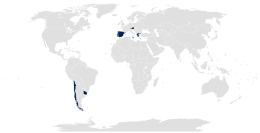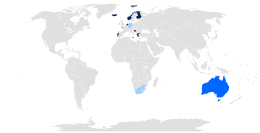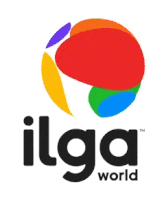
The International Lesbian, Gay, Bisexual, Trans and Intersex Association (ILGA) is an organization which is committed to advancing human rights to all people, disregarding gender identity, sex characteristics and expression. ILGA participates in a multitude of agendas within the United Nations, such as creating visibility for LGBTI issues by conducting advocacy and outreach at the Human Rights Council, working with members to help their government improve LGBTI rights, ensuring LGBTI members are not forgotten in international law, and advocating for LBTI women's issues at the Commission on the Status of Women.

Lesbian, gay, bisexual and transgender (LGBT) rights in India have been evolving rapidly in recent years. However, Indian LGBT citizens continue to face social and legal difficulties not experienced by non-LGBT persons.

Lesbian, gay, bisexual and transgender (LGBTQ) people face active discrimination in Bangladesh. Due to the conservative attitudes in Bangladeshi society, negative views of homosexuals are very high. Homosexuality is illegal under Bangladeshi law, which is inherited from the colonial British Indian Government's Section 377 of 1860. According to the law, the punishment for engaging in same-sex sexual activities is imprisonment. It is dangerous for those who identify as homosexuals to openly come out in society because of social rejection, hate or assault.

Lesbian, gay, bisexual, and transgender (LGBT) persons in Sri Lanka face significant challenges not experienced by non-LGBT residents. Article 365 of the Sri Lankan Penal Code, which dates from the time of colonial British Ceylon, criminalizes sexual acts deemed "against the order of nature". This has been ruled unenforceable by the Supreme Court, but the court does not have the power to remove laws outright. A private members' bill submitted to parliament in August 2022 has been given the support of the ruling government and is likely to be passed by parliament in 2023.
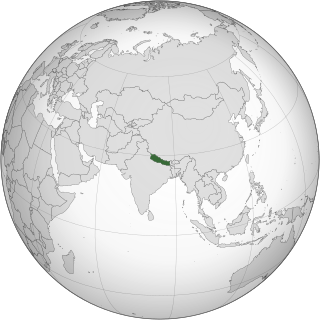
Lesbian, gay, bisexual, and transgender (LGBT) rights in Nepal have evolved significantly during the 21st century. In 2007 Nepal repealed the laws against gay sex and introduced several laws which explicitly protected "gender and sexual minorities". The Nepalese Constitution now recognizes LGBT rights as fundamental rights. On 28 June 2023, a single judge bench of Justice Til Prasad Shrestha issued a historic order directing the government to make necessary arrangements to "temporarily register" the marriages of "non-traditional couples and sexual minorities". The government has not responded yet. If Nepal fully legalises same-sex marriage, it will become the first least developed country to legalize same-sex marriage. Nepal has not yet passed a national same-sex marriage law.

Lesbian, gay, bisexual, transgender (LGBT) rights in Kosovo have improved in recent years, most notably with the adoption of the new Constitution, banning discrimination based on sexual orientation. Kosovo remains one of the few Muslim-majority countries where LGBT pride parades are held annually.

Lesbian, gay, bisexual and transgender (LGBT) rights in Tamil Nadu are the most progressive among all states of India. Tamil Nadu was the first state in India to introduce a transgender welfare policy, wherein transgender individuals can access free gender affirmation surgery in government hospitals and various other benefits and rights. The state was also the first to ban forced sex-selective surgeries on intersex infants, and also the first state to include an amendment in its state police guidelines that expects officers to abstain from harassing the LGBTQIA+ community and its members. The state also became the first to ban conversion therapy and the first to introduce LGBTQIA+ issues in school curricula.
Same-sex marriage has been technically legal in Nepal, though not legislatively supported by the government, since 28 June 2023 in accordance with a ruling from the Supreme Court.

Discussions of LGBT rights at the United Nations have included resolutions and joint statements in the United Nations General Assembly and the United Nations Human Rights Council (UNHRC), attention to the expert-led human rights mechanisms, as well as by the UN Agencies.
The Blue Diamond Society is an LGBT rights organization in Nepal. It was established in 2001 to advocate for change in the existing laws against homosexuality and to advocate for the rights of Nepal's marginalized gay, transgender and other sexual minority communities. The Blue Diamond Society also aims to educate Nepalese society on proper sexual health, to advocate with local governments for queer minorities, to encourage the artful expression of LGBTQ+ youth, and to document violence against Nepalese queers. Another of its contributions to Nepal's LGBTQ+ communities is to provide care, counseling, and services to victims of HIV/AIDS.The BDS has also recorded various abuses against the community ranging from physical and verbal abuse and discrimination inflicted in workplaces and healthcare facilities.
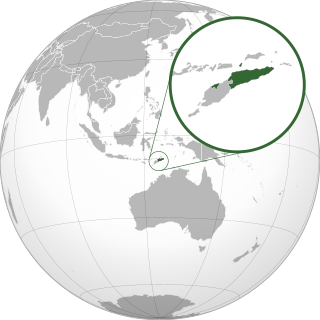
Lesbian, gay, bisexual, and transgender (LGBT) people in East Timor face legal challenges not experienced by non-LGBT residents. Both male and female same-sex sexual activity are legal in East Timor, but same-sex couples and households headed by same-sex couples are not eligible for the same legal protections available to opposite-sex married couples.

The Yogyakarta Principles is a document about human rights in the areas of sexual orientation and gender identity that was published as the outcome of an international meeting of human rights groups in Yogyakarta, Indonesia, in November 2006. The principles were supplemented and expanded in 2017 to include new grounds of gender expression and sex characteristics and a number of new principles. However, the Principles have never been accepted by the United Nations (UN) and the attempt to make gender identity and sexual orientation new categories of non-discrimination has been repeatedly rejected by the General Assembly, the UN Human Rights Council and other UN bodies.

Intersex Human Rights Australia (IHRA) is a voluntary organisation for intersex people that promotes the human rights and bodily autonomy of intersex people in Australia, and provides education and information services. Established in 2009 and incorporated as a charitable company in 2010, it was formerly known as Organisation Intersex International Australia, or OII Australia. It is recognised as a Public Benevolent Institution.

Intersex people are born with sex characteristics, such as chromosomes, gonads, or genitals, that, according to the UN Office of the High Commissioner for Human Rights, "do not fit typical binary notions of male or female bodies."

Intersex people are born with sex characteristics, such as chromosomes, gonads, or genitals that, according to the UN Office of the High Commissioner for Human Rights, "do not fit typical binary notions of male or female bodies". "Because their bodies are seen as different, intersex children and adults are often stigmatized and subjected to multiple human rights violations".

Intersex people are born with sex characteristics that "do not fit the typical definitions for male or female bodies". They are substantially more likely to identify as lesbian, gay, bisexual, or transgender (LGBT) than the non-intersex population, with an estimated 52% identifying as non-heterosexual and 8.5% to 20% experiencing gender dysphoria. Although many intersex people are heterosexual and cisgender, this overlap and "shared experiences of harm arising from dominant societal sex and gender norms" has led to intersex people often being included under the LGBT umbrella, with the acronym sometimes expanded to LGBTI. Some intersex activists and organisations have criticised this inclusion as distracting from intersex-specific issues such as involuntary medical interventions.

Intersex rights in New Zealand are protections and rights afforded to intersex people. Protection from discrimination is implied by the Human Rights Act and the Bill of Rights Act, but remains untested. The New Zealand Human Rights Commission states that there has seemingly been a "lack of political will to address issues involved in current practices of genital normalisation on intersex children".

The Malta declaration is the statement of the Third International Intersex Forum, which took place in Valletta, Malta, in 2013. The event was supported by the ILGA and ILGA-Europe and brought together 34 people representing 30 organisations from multiple regions of the world.

Intersex people are born with sex characteristics, such as chromosomes, gonads, hormones, or genitals that, according to the UN Office of the High Commissioner for Human Rights, "do not fit the typical definitions for male or female bodies". Such variations may involve genital ambiguity, and combinations of chromosomal genotype and sexual phenotype other than XY-male and XX-female.
Esan Regmi is a prominent Nepali intersex man and intersex human rights activist. He founded Nepal's first and only intersex-led organization called Campaign for Change back in 2017, and he is one of the co founders of International NGO Intersex Asia.


